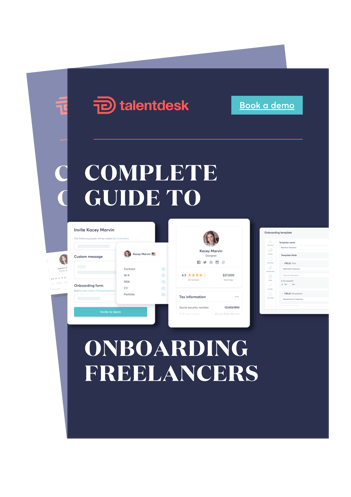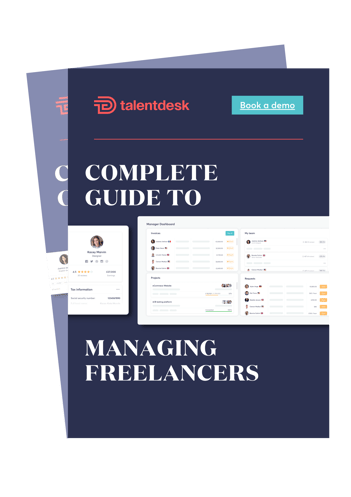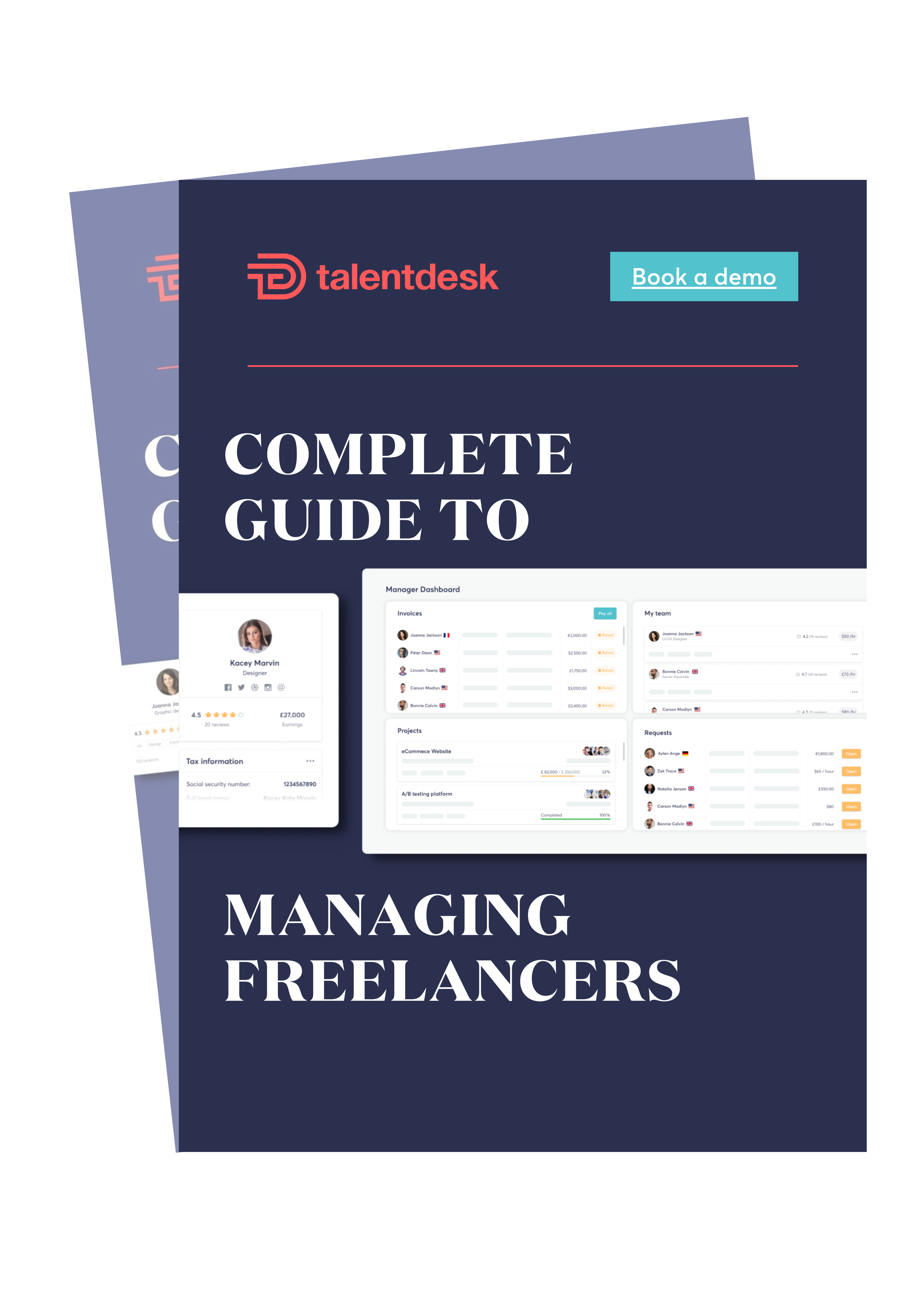The Complete Guide to Working with Freelancers
This collection of guides will guide you through the world of freelancer management
When it comes to working with and managing freelancers, like most other areas of business, you need to be super organised to maximise the results. Unfortunately, the constant juggling of projects and trying to keep track of everything can feel overwhelming.
This is often because there are few systems and processes in place to make every step more efficient. As a result, everyone managing outsourcing projects ends up reinventing the wheel time and time again.
In this guide we hope to change that and bring consistency and visibility on a greater scale – not just for managers dealing with freelancers on a day-to-day basis but also so that the whole organisation can benefit from being more in control including finance, HR and business owners. Discover key tips for managing freelancers and ensure working with them is as seamless as possible.

The Complete Guide to Hiring Freelancers
When it comes to hiring freelancers, there are several steps you need to think about or go through. These include:
1. Do you really need to outsource?
Many organisations outsource without a clear vision of what they want to achieve or the overall impact on business. It’s often the case that HR, finance and even the business owner or department head don’t have visibility of the projects taking place and the freelancers carrying out work for the organisation.
Are there multiple people in your organisation outsourcing projects for similar skills? This might lead HR to suggest hiring someone internally and creating a role for those particular types of projects and tasks, rather than outsource.
2. Creating a great job description
If there’s a genuine need to outsource, you’ll want to create a written job (aka project) description. Keep this direct and on point so that you articulate the project succinctly, outlining exactly what’s entailed and the skills required.
Good freelancers will see many project opportunities every day and will be choosy about which ones they pick. That means you need to sell your project to attract freelancers of the highest calibre. A great job description also clarifies what your overall objective is and is an important exercise in its own right.
3. Tightening up your search skills
With your job description in hand, you’ll next need to post it on the recruitment platforms of choice. You may also want to target specific freelancers. Whilst you might be aware of sources such as personal networks, social media and freelancer platforms, when it comes to searching you can always be more efficient.
The great news is, there are many ways to speed up your search. This includes the proper use of filters on freelancer platforms to narrow down your target audience fast. You can also add a power boost to LinkedIn’s filters by combining them with boolean search.
4. Mastering the art of the interview
If you think you’ve found the right freelancer, you’ll definitely want to check that your assumption is correct. This means knowing what you want to achieve and having a conversation with purpose.
The best way to do this is to create a clear framework for your interview questions. This will ensure that no important factors are left out of the equation. It will also make the interview process much more efficient – and provide you with a handy blueprint for future interviews.
Compliance in Vendor Management
Vendor Risk Management – How to Identify, Assess & Control Third-Party Risks
Contract Management in Vendor Relationships

The Complete Guide to Onboarding Freelancers
Having a procedure in place ensures you start off on the right foot with your freelancer, and helps to make sure that you keep compliant – something which every business should take seriously.
1. Onboarding freelancers
When you onboard freelancers for projects, you’ll want to make sure you’ve got all their necessary information, including full contact details, signed agreements and payment details. One important factor to bear in mind is that this is different to onboarding an employee.
The freelancer is a business in their own right and should be treated as such - particularly when it comes to working practices. They’re not subject to the same internal employee procedures, but are essentially a supplier, so you should consider this a business-to-business relationship.
2. Remaining compliant
When it comes to compliance, you’ll need to make sure you fully understand the impact of the General Data Protection Regulation (GDPR). This gives individuals, including freelancers, more rights over their personal information, which should always be kept in a GDPR-compliant system.
If you work within the UK, IR35 legislation is important to understand as well. It is set to change in April 2020 for mid to large organisations in the private sector, so that the onus falls on the "fee payer" to determine a freelancer or contractor’s employment status. This is certainly one to seek legal guidance on.
Compliance in Vendor Management
Vendor Risk Management – How to Identify, Assess & Control Third-Party Risks
Contract Management in Vendor Relationships

The Complete Guide to Managing Freelancers
Wondering how to manage freelancers? The day-to-day management of outsourced projects can become a nightmare – particularly if there are a number of them running in parallel. Having highly efficient processes in place will help you keep on track.
1. Creating a project brief
Like the job description, the project brief should be tightly focused to provide only the necessary details. Make the objectives SMART, provide key deliverables and ensure that any milestones and timelines are clearly laid out.
Additional information such as audience, benchmarks, branding and other specific details that are important to the success of the project are also be included.
2. Providing clear communication
The quality of the outcomes you get when working with freelancers will be driven by the quality of your communication. This applies to your briefs, discussed above, and also every other interaction you have with freelancers.
Always think about the outcome you want before you have a call with a freelancer, write an email or any other form of communication method you use. Good communication can ensure that you articulate project requirements and changes well, leading to a better end result for all.
3. Managing multiple projects
When it comes to managing projects with freelancers in parallel, it is important to work collaboratively, maintain accountability and visibility.
Having the right tools in place across the organisation will help you achieve this. This is useful in information consolidation and gaining a better view of outsourced projects and their status'.
Freelancer Management System (FMS) vs Vendor Management System (VMS)
10 Best Freelancer Management Software (FMS) Tools to Consider in 2025
Integrating Accounting Systems with Freelancer Platforms

The Complete Guide to Paying Freelancers
Paying all your freelancers around the world need not be a time-consuming, effort-intensive chore. The process can be seamless and hassle-free – but it will require some organization at the start of the engagement.
1. Have a clear agreement
2. Create a schedule
You will find it difficult to process each invoice as soon as it comes in – especially if you’re working with several professionals on multiple projects simultaneously.
Set up a payment schedule that allows you to pay out your invoices in batches. This can be a monthly schedule, a fortnightly schedule or anything else that works for you.
3. Automate the process
Processing invoices manually can quickly become overwhelming. It requires you to verify each invoice, cross check timesheets, give out approvals and then send it to the accounts department to be paid out. Don’t forget the multiple follow ups!
An easier way is to adopt a system that automates the invoicing process, consolidates all approved worksheets and generates a single invoice for you to pay. One click and you’re done!
4. Maintain audit trails
Effective Budget Management for Freelance Projects
Integrating Accounting Systems with Freelancer Platforms
What are Global Payroll Providers: Understanding Payroll Systems
Summary
Once you’ve downloaded the guides, you can create your own blueprint for working with freelancers and share it across your business. Work with HR and finance to ensure they’re kept in the loop.
There are many tools out there to help you with this, including freelancer management systems such as TalentDesk.io. These can automate and streamline processes even more, bringing every element we’ve talked about above neatly together.
Why we’re here
We’ve spent over 15 years in the contractor and freelancer space, working alongside millions of businesses.
That’s why we took our learnings and built a solution which enables companies to seamlessly assemble, pay and manage their contractors, wherever they may be.
Why us? Because we’re just like you. And we’re here to help transform your workforce to one that’s borderless, flexible and efficient.

.png?height=391&name=guides%20images%20final%20(1).png)


